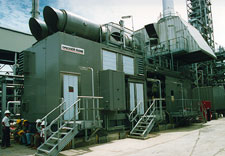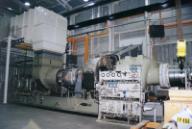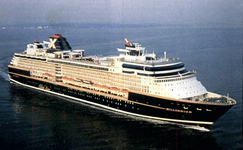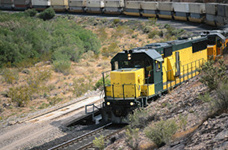People have been harnessing the power of flowing gases for
thousands of years with windmills. The first modern gas turbine was built
100 years ago, but in the last 50 years the technology has been dramatically
improved.
| Aircraft ('Jet Engine') |
 |
This is probably the most familiar example of the modern
gas turbine.
Gas turbines have made a big impact on aircraft design.
The gas turbine engine has almost completely replaced the reciprocating
engine for aircraft propulsion.
|
|
Jet engines derive thrust by ejecting the products of
combustion in a jet. In simplest terms, a jet engine ingests air, heats
it, and ejects it at high speed.
Because its basic design employs rotating rather than
reciprocating parts, a jet engine is far simpler than a reciprocating
engine of equivalent power, weighs less, is more reliable, requires
less maintenance, and has a far greater potential for generating power.
It does, however, consumes fuel at a faster rate. Some of the specific
aeronautical variations on the simplest gas turbine are: turbofan, turboprop,
propfan, rocket, ramjet and scramjet.
|
| Power Generation |
 |
When you’re talking about burning
a liquid or gaseous fuel to generate electricity, gas turbines are the
prime mover of choice.
At sufficiently large sizes, gas
turbines are cheaper, lighter and more efficient than steam turbines
or engines.
|
|
Furthermore, they require less space and can be quickly
brought into operation. They do not require elaborate foundations and
can be dropped on a simple concrete pad. In a matter of weeks, a gas
turbine can be delivered, hooked up to the grid and a fuel source, and
be in operation.
On a day-to-day basis, gas turbines can be started and
operational in a matter of minutes, whereas steam turbines (and their
associated equipment) can take hours to start-up. For these reasons,
gas turbines have found a niche in the medium sized, ‘peak’ generating
stations – power plants that are turned on and operated intermittently
during periods of high demand.
|
| Industrial Uses |
 |
Gas turbines can be found in a
number of industrial processes.
One of the more common applications
is driving the compressors used on natural gas pipelines. These units
are often automated so that only occasional on-site supervision is required.
|
|
Small portable gas turbines with centrifugal compressors
have also been used to operate pumps. They can be found in oil refineries
as part of the Houdry process (where pressurized air, passing over a
catalyst burns off accumulated carbon).
|
| Marine Applications |
 |
Because gas turbines can deliver a lot of power (up
to 20,000 horsepower) while remaining lightweight and compact, they
have been incorporated into the designs of many types of ships by the
world’s navies. They are also used in merchant ships.
|
|
|
| Transportation |
 |
Gas turbines have been tested in locomotives and automobiles.
In spite of their small size and weight compared to their power output,
they have not been wildly successful because they are inefficient at
partial loads (or idling), and have low thermal efficiencies.
|
|
|
|